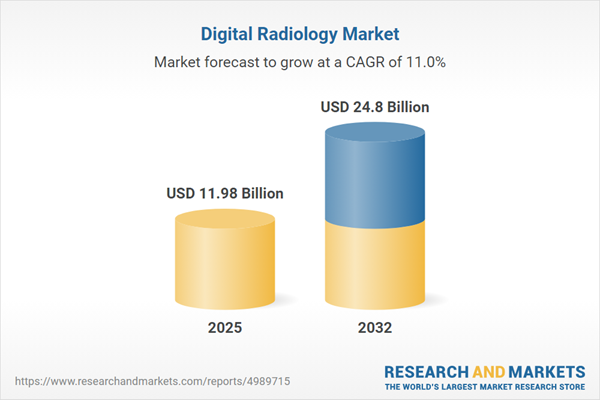Speak directly to the analyst to clarify any post sales queries you may have.
Digital radiology delivers advanced imaging solutions designed for senior healthcare leaders seeking operational efficiency and superior diagnostic accuracy. As care settings become increasingly intricate, digital radiology empowers organizations to reshape workflow management, strengthen compliance, and adapt to evolving clinical demands.
Market Snapshot: Digital Radiology Market Size and Growth
The digital radiology market reached a global valuation of USD 10.78 billion in 2024 and is expected to climb to USD 11.98 billion by 2025, with projections indicating USD 24.80 billion by 2032. This growth reflects a robust compound annual growth rate (CAGR) of 10.96%, supported by heightened investment in next-generation imaging technologies and expanding adoption of interoperable platforms.
The steady momentum is propelled by demand for integrated care models and technologies that position healthcare providers to navigate changing clinical and regulatory landscapes more effectively.Scope & Segmentation of the Digital Radiology Market
- Component: Imaging infrastructure encompasses core hardware elements such as detectors, magnets, transducers, and X-ray tubes, seamlessly integrated with AI-driven software, PACS, and information systems. Services including consulting, installation, training, and maintenance are crucial to sustaining reliable performance.
- End User: Hospitals and networks utilize digital radiology for large-scale, efficient diagnostics, while diagnostic centers rely on modularity for flexible response to shifting patient volumes. Small clinics prioritize rapid access and intuitive use, tailoring solutions to their day-to-day needs.
- Application: Solutions address critical needs in cardiology, oncology, neurology, orthopedics, and gastroenterology. They support real-time monitoring, enhance clinical decision-making, and drive higher productivity across specialist teams.
- Deployment Mode: Cloud-based deployment facilitates quick scaling and secure access across multiple sites, streamlining workflows and data integration. On-premise models provide organizations with enhanced control over information and compliance, supporting bespoke data strategies.
- Geography: Market presence spans the Americas, Europe, Middle East and Africa, and Asia-Pacific. Regional strategies reflect local policies, reimbursement differences, and distinct regulatory environments, requiring tailored adoption and investment approaches.
- Key Players Analyzed: General Electric Company, Siemens Healthineers AG, Koninklijke Philips N.V., Canon Medical Systems Corporation, Fujifilm Holdings Corporation, Agfa-Gevaert N.V., Carestream Health, Inc., Konica Minolta, Inc., Samsung Electronics Co., Ltd., and Hologic, Inc.; all contribute to sector advancement through technological and collaborative initiatives.
Key Takeaways for Decision-Makers
- Artificial intelligence and analytics integrations significantly advance diagnostic precision while optimizing workflows and resource allocation within healthcare organizations.
- Cloud-native imaging platforms expand the reach of teleradiology, making multi-site operations more connected and supporting coordinated patient care across locations.
- Subscription-based models introduce scalable imaging acquisition, allowing providers to align capital investments with fluctuating service levels and control acquisition costs.
- Effective data governance remains fundamental to connecting radiology systems with electronic health records, ensuring compliant image sharing and protecting sensitive data.
- Regional trends show accelerated market expansion in Asia-Pacific and compliance-driven modernization in Western Europe. Local policy adaptation and tech-readiness strongly influence organizational strategy.
- Investment in modular, scalable infrastructure enables providers to strengthen operational partnerships and rapidly adjust to shifting clinical and regulatory requirements in various healthcare systems.
Tariff Impact on Digital Radiology Supply Chains
Upcoming U.S. trade tariffs slated for 2025 are prompting market stakeholders to revisit procurement and sourcing strategies, enhancing flexibility to offset potential cost volatility. Healthcare organizations are adopting more agile, diverse supply chain models. Enhanced equipment longevity is achieved through modular upgrades and strategic retrofits, supporting compliance while controlling lifecycle costs.
Methodology & Data Sources
This analysis is based on interviews with senior executives across hardware, software, and service domains. It synthesizes insights from peer-reviewed studies, regulatory publications, patent evaluations, and sector-specific expert forums, providing a comprehensive, multi-perspective market assessment.
Why This Report Matters for Decision-Makers
- Guides executive decisions with actionable strategies for technology adoption, investment alignment, and effective market entry.
- Offers practical frameworks for overcoming compliance, logistics, and implementation barriers in diverse care settings.
- Equips leaders to select platforms that balance operational reliability, scalability, and quality of patient care in the face of sector evolution.
Conclusion
Digital radiology is a catalyst for improved care delivery and organizational resilience. Executives will find this report useful for shaping investments and future-proofing clinical infrastructure in a rapidly changing healthcare landscape.
Additional Product Information:
- Purchase of this report includes 1 year online access with quarterly updates.
- This report can be updated on request. Please contact our Customer Experience team using the Ask a Question widget on our website.
Table of Contents
3. Executive Summary
4. Market Overview
7. Cumulative Impact of Artificial Intelligence 2025
Companies Mentioned
The companies profiled in this Digital Radiology market report include:- General Electric Company
- Siemens Healthineers AG
- Koninklijke Philips N.V.
- Canon Medical Systems Corporation
- Fujifilm Holdings Corporation
- Agfa-Gevaert N.V.
- Carestream Health, Inc.
- Konica Minolta, Inc.
- Samsung Electronics Co., Ltd.
- Hologic, Inc.
Table Information
| Report Attribute | Details |
|---|---|
| No. of Pages | 192 |
| Published | October 2025 |
| Forecast Period | 2025 - 2032 |
| Estimated Market Value ( USD | $ 11.98 Billion |
| Forecasted Market Value ( USD | $ 24.8 Billion |
| Compound Annual Growth Rate | 10.9% |
| Regions Covered | Global |
| No. of Companies Mentioned | 11 |









